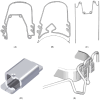Comparative Experimental Evaluation of Orthodontic Appliances for Maxillary Arch Expansion
- PMID: 39518612
- PMCID: PMC11546383
- DOI: 10.3390/jcm13216473
Comparative Experimental Evaluation of Orthodontic Appliances for Maxillary Arch Expansion
Abstract
Background/Objectives: The orthodontic treatment of posterior crossbite using appliances for gradual maxillary expansion is crucial to ensure proper transversal jaw relationships as much as occlusal functionality. The aim of this study was to analyze forces and torques generated by different appliances for maxillary expansion. Methods: Measurements were conducted for the Wilson® 3D® Quadhelix (WQH) and Wilson® 3D® Multi-Action Palatal Appliance (WPA) across various sizes and compared to the Remanium® Quadhelix (RQH). Activations were set to 8 mm for the WQH and RQH and 6 and 8 mm for the WPA. Rotations and root torque were simulated via an activation of 10° for arches. A total of eight test series were conducted. Results: The WPA displayed the highest force and torque values for all movements, far surpassing recommended guideline values (expansion 8.5->15.0 N/46.3-86.5 Nmm, rotation 3.1-6.1 N/40.7-61.4 Nmm, torque 3.9-5.1 N/22.4-29.7 Nmm), and the WQH displayed the lowest values (expansion 2.7-12.6 N/11.1-39.6 Nmm, rotation 0.1-1.7 N/23.0-32.2 Nmm, torque 0.9-2.9 N/3.4-10.5 Nmm). Appliances with the smallest transverse dimensions exhibited the highest force and torque maxima. Conclusions: This study underscores the importance of understanding biomechanical principles in orthodontics for minimizing unintended tooth movements, providing detailed insights into the force systems of appliances acting in the transverse plane, and establishing a foundation for future clinical investigations to validate these in vitro findings.
Keywords: arch expansion; orthodontic forces; posterior crossbite; quadhelix; torque.
Conflict of interest statement
The authors declare no conflict of interest.
Figures





Similar articles
-
A randomized controlled trial comparing the quadhelix and the expansion arch for the correction of crossbite.J Orthod. 2005 Mar;32(1):29-35. doi: 10.1179/146531205225020769. J Orthod. 2005. PMID: 15784941 Clinical Trial.
-
Evaluation and comparison of stresses and displacements generated by four different types of asymmetric maxillary expansion appliances in true unilateral crossbite using finite element method.Int Orthod. 2022 Sep;20(3):100668. doi: 10.1016/j.ortho.2022.100668. Epub 2022 Jul 22. Int Orthod. 2022. PMID: 35879207
-
Symmetric and asymmetric expansion of molars using a Burstone-type transpalatal arch. Biomechanical and clinical analysis.J Orofac Orthop. 2015 Sep;76(5):377-90. doi: 10.1007/s00056-015-0298-0. J Orofac Orthop. 2015. PMID: 26250453 Clinical Trial.
-
Tooth-borne versus bone-borne rapid maxillary expansion for transverse maxillary deficiency: A systematic review.Int Orthod. 2019 Sep;17(3):425-436. doi: 10.1016/j.ortho.2019.06.003. Epub 2019 Jul 4. Int Orthod. 2019. PMID: 31280998
-
Maxillary transverse deficiency, with closed intermaxillary suture, does bone-anchored appliance during SARPE cause predictable, and stable maxillary expansion compared to the tooth-borne appliance during SARPE - Systematic review.J Stomatol Oral Maxillofac Surg. 2023 Feb;124(1S):101344. doi: 10.1016/j.jormas.2022.11.020. Epub 2022 Nov 24. J Stomatol Oral Maxillofac Surg. 2023. PMID: 36435445
Cited by
-
Mandibular Dentoalveolar Expansion in Early Mixed Dentition Using the Clara Expander: A Case Series.Children (Basel). 2025 Jul 18;12(7):951. doi: 10.3390/children12070951. Children (Basel). 2025. PMID: 40723144 Free PMC article.
References
-
- Bell R.A., Kiebach T.J. Posterior crossbites in children: Developmental-based diagnosis and implications to normative growth patterns. Semin. Orthod. 2014;20:77–113. doi: 10.1053/j.sodo.2014.04.002. - DOI
-
- Almaqrami B.S., Alhammadi M.S., Tang B., ALyafrusee E.S., Hua F., He H. Three-dimensional morphological and positional analysis of the temporomandibular joint in adults with posterior crossbite: A cross-sectional comparative study. J. Oral. Rehabil. 2021;48:666–677. doi: 10.1111/joor.13156. - DOI - PubMed
-
- Myllymäki E., Heikinheimo K., Suominen A., Evälahti M., Michelotti A., Svedström-Oristo A.L., Rice D.P. Longitudinal trends in temporomandibular joint disorder symptoms, the impact of malocclusion and orthodontic treatment: A 20-year prospective study. J. Oral. Rehabil. 2023;50:739–745. doi: 10.1111/joor.13471. - DOI - PubMed
LinkOut - more resources
Full Text Sources

